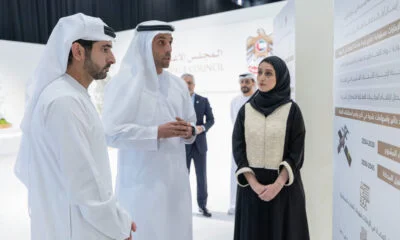News
NASA Chooses Lockheed Martin To Build Nuclear Mars Rocket
The spacecraft will use a reactor from BWX Technologies to travel to the red planet.

NASA and DARPA have chosen Lockheed Martin to build a spacecraft featuring a nuclear rocket engine. The project is known as the Demonstration Rocket for Agile Cislunar Operations (DRACO), and should be ready for trials by 2027, in the hope that it will eventually be used for missions to Mars.
The rocket will use Nuclear thermal propulsion (NTP), which has several advantages over conventional chemical-powered engines. Nuclear power is up to five times more efficient than rocket fuel, which means that future spacecraft will be able to travel significantly further with a larger payload.
“These more powerful and efficient nuclear thermal propulsion systems can provide faster transit times between destinations,” explained Kirk Shireman, VP of Lunar Exploration Campaigns for Lockheed Martin. “Reducing transit time is vital for human missions to Mars to limit a crew’s exposure to radiation”.

The NTP system will use a nuclear reactor to rapidly heat hydrogen propellant to very high temperatures. The gas is then funneled through the engine’s nozzle, creating thrust. “This nuclear thermal propulsion system is designed to be extremely safe and reliable, using High Assay Low Enriched Uranium (HALEU) fuel to rapidly heat a super-cold gas,” explained reactor developers BWX Technologies. “As the gas is heated, it expands quickly and creates thrust to move the spacecraft more efficiently than typical chemical combustion engines”.
Also Read: Take A Balloon Journey To Space, Complete With Fine Dining!
To help alleviate concerns about radioactive leaks, NASA and DARPA will use a conventional rocket to take the new spacecraft out of Earth’s orbit before powering up the reactor after the ship has reached a safe distance.
News
Alienware Just Announced Six New Gaming Monitors
The new models include three QD-OLED and three budget-friendly QHD options, expanding the company’s lineup for all gamers.

Alienware has just updated its gaming monitor lineup with six new additions, including the highly anticipated Alienware 27 4K QD-OLED Monitor. The latest wave of releases is set to reach more gamers than ever, offering high-end QD-OLED displays alongside more budget-friendly options.
The latest displays clearly show that the company is doubling down on QD-OLED with three new models sporting the technology. A redesigned Alienware 34 Ultra-Wide QD-OLED Monitor is also making a return, further refining what is already a fan-favorite display.
A Unified Design: The AW30 Aesthetic
All six monitors feature Alienware’s new AW30 design language, first introduced at CES. The AW30 aesthetic brings a futuristic, minimalist look that unites the entire lineup under a cohesive visual identity.
Pushing QD-OLED Even Further
The refreshed Alienware 34 Ultra-Wide QD-OLED Monitor (AW3425DW) builds on its predecessor’s success with a 240Hz refresh rate (up from 175Hz) and HDMI 2.1 FRL support. It also gains G-SYNC Compatible certification alongside AMD FreeSync Premium Pro and VESA AdaptiveSync, ensuring ultra-smooth performance. With a WQHD (3440×1440) resolution and an 1800R curve, this display enhances immersion for both gaming and cinematic experiences.
For those who crave speed, the Alienware 27 280Hz QD-OLED Monitor (AW2725D) pairs a high refresh rate with QHD resolution, balancing sharp visuals with ultra-smooth gameplay. Meanwhile, the Alienware 27 4K QD-OLED Monitor (AW2725Q) delivers stunning clarity with an industry-leading pixel density of 166 PPI, making it the sharpest OLED or QD-OLED monitor available.
Also Read: Infinite Reality Acquires Napster In $207 Million Deal
Worried about OLED burn-in? Alienware’s entire QD-OLED lineup comes with a three-year limited warranty covering burn-in concerns, offering peace of mind for gamers investing in these high-end displays.
Bringing QHD To A Wider Audience
Alongside QD-OLED, Alienware is also releasing three new QHD gaming monitors aimed at more price-conscious gamers. The Alienware 34 Gaming Monitor (AW3425DWM), Alienware 32 Gaming Monitor (AW3225DM), and Alienware 27 Gaming Monitor (AW2725DM) provide a range of sizes and formats to suit different preferences:
- The Alienware 34 Gaming Monitor (AW3425DWM): An ultrawide (WQHD) option for a panoramic, immersive experience.
- The Alienware 32 Gaming Monitor (AW3225DM): A standard 16:9 panel for a traditional but expansive desktop setup.
- The Alienware 27 Gaming Monitor (AW2725DM): A 27” display offering the same performance in a more compact form factor.
All three gaming monitors feature a fast 180 Hz refresh rate, a 1ms gray-to-gray response time, and support for NVIDIA G-SYNC, AMD FreeSync, and VESA AdaptiveSync to eliminate screen tearing. Additionally, with 95% DCI-P3 color coverage and VESA DisplayHDR400 certification, these displays deliver vibrant colors and high dynamic range for lifelike visuals.



























